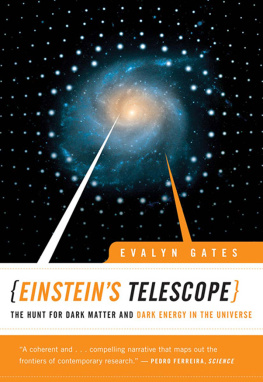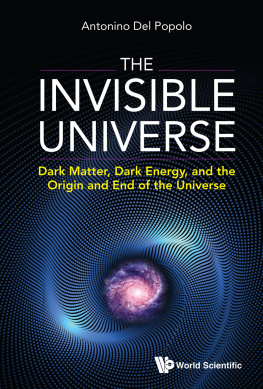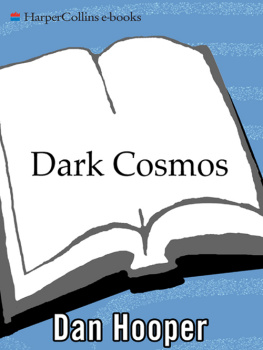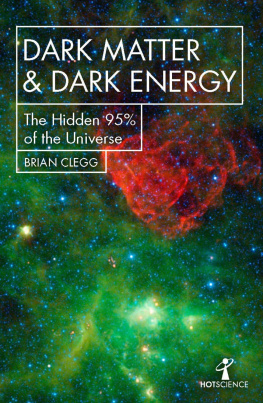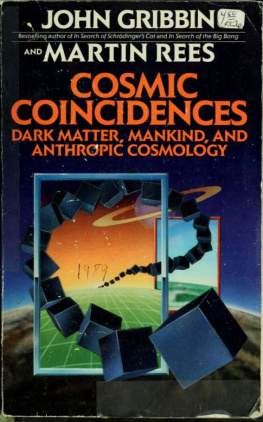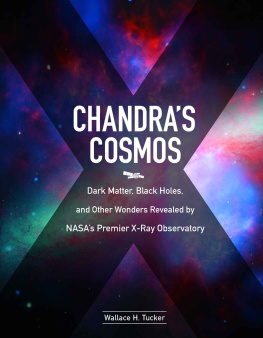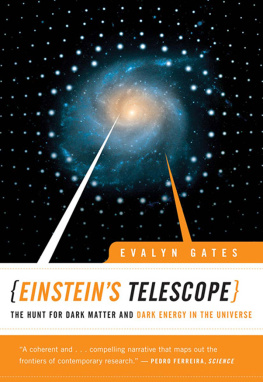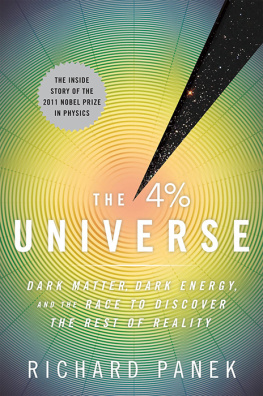W. W. Norton & Company
For information about permission to reproduce selections from this book, write to Permissions, W. W. Norton & Company, Inc., 500 Fifth Avenue, New York, NY 10110
Gates, Evalyn.
Einsteins telescope: the hunt for dark matter and dark energy in the universe / Evalyn Gates.
p. cm.
Includes bibliographical references.
ISBN: 978-0-494-07133-7
1. Dark matter (Astronomy) 2. Dark energy (Astronomy) I. Title.
QB791.3.G38 2009
W. W. Norton & Company, Inc.
500 Fifth Avenue, New York, N.Y. 10110
www.wwnorton.com
W. W. Norton & Company Ltd.
Castle House, 75/76 Wells Street, London W1T 3QT

color illustration 1 Einstein Rings. Astronomers utilized the combined power of the Hubble Space Telescope and the Sloan Digital Sky Survey to find eight new Einstein Rings in 2005. At the center of each image is a bright orange-yellow galaxy located a few billion light-years from Earth. Directly behind each of these galaxies is a second galaxy, roughly twice as far away from us, whose light has been bent into the blue ring that appears to encircle the closer galaxy. If the lensing galaxy were not there, the more distant galaxy would appear as a small blue smudge.

color illustration 2 Giant Arc. At the center of this image from the Hubble Space Telescope is a bright yellow-orange galaxy about 6 billion light-years away from us. Just above the center of this galaxy is a much more distant galaxy (roughly 10 billion light-years away) whose light has been stretched and curved into a large blue arc by gravitational lensing, revealing the warp in space induced by the mass of the closer galaxy.

color illustration 3 A MACHO event. From left to right, top to bottom, these 12 panels are sequential images of a field of stars in our closest galactic neighbor, the Large Magellanic Cloud, taken over a period of 90 days. The arrow points to a star that is being lensed by an invisible MACHO. Over the course of about 34 days the light of this star was magnified by the MACHO to a maximum level of about seven times its original value (seventh panel). The first and last panels show the star as it appears before and after the MACHO passes by (note that the star is one of the fainter stars in this field).

color illustration 4 Mapping dark matter. (a) Gravitational lensing by a cluster. The bright yellow-orange objects in this image are galaxies that are members of a cluster of galaxies (CL 0024+1654). The odd-looking blue objects seen at about four, eight, nine, and ten oclock (and also near the very center of the image) are multiple images of a single distant galaxy that is not part of the cluster, but billions of light years behind it. The mass of the cluster acts as a lens to bend and distort the light from this distant galaxystretching, magnifying, and multiplying the original to create five copies. ( See for annotated version. )

(b) A complex lens. Although only the galaxies in CL 0024+1654 are visible in the Hubble image above, most of the mass in the cluster is in the form of invisible dark matter. Shown here is a map of the total mass in the cluster, constructed from the observations of multiple images of a single blue galaxy created by gravitational lensing. The sharp peaks correspond to the mass and position of individual galaxies in the cluster; the underlying mountain represents the dark matter that comprises the bulk of the cluster mass.

color illustration 5 Quasar quintuplets. The bright orange galaxy at the center of this image taken by the Hubble Space Telescope is the central galaxy of a cluster (known officially as SDSS J1004+4112) lens that has created five images of a single distant quasar (four can be seen as the bright, white, star-like objects at four, eight, eleven, and twelve oclock about the central galaxy; the fifth is hidden in the glare of this galaxy) and multiple images of several other distant galaxies. ( See for details. )

color illustration 6 A massive lens. Faint blue and red arcs can be seen circling about the center of cluster Abell 1689, one of the largest and most powerful gravitational lenses found to date, creating an almost Van Goghlike effect. Over 100 arcs have been identifiedmultiple copies of 30 distant galaxies. The bright yellow objects are galaxies in the cluster, which is 2.2 billion light-years from Earth; the bright white spiked objects are stars in our own Galaxy.

color illustration 7 A cosmic magnifying glass. The mass in cluster Abell 2218 creates an enormous dent in spacetime, which acts as a gravitational lens. This lens stretches and magnifies the images of galaxies that lie behind it, affording scientists a view of some of the most distant galaxies ever seen, over 12 billion light-years away. Without the magnifying power of the cluster lens, these ancient galaxies would be too faint to be detected even by the Hubble Space Telescope.

color illustration 8 The Bullet cluster. This image is a composite created from a Hubble Space Telescope image (optical light), X-ray observations of the same region of the sky (pink), and gravitational lensing data (blue). The Bullet cluster is actually two clusters that have recently collided with one another, and are visible in optical light as a large group of galaxies just to the left of the center of the image, and a smaller group to the right. (Bright spiked objects are stars in our own Galaxy.) Overlaid on this image is the distribution of hot gas detected by X-ray telescopes and shown here in pink. In blue is the distribution of matter in the clusters derived from gravitational lensing studies .

color illustration 9 A computer simulation of the cosmic web. A slice of the simulated universe roughly 68 million light-years thick and 1.7 billion light-years across. At the center is a bright spot representing a cluster of galaxies. (a) Normal matter only (galaxies, clusters, and gas).

